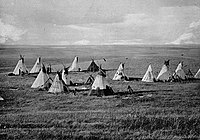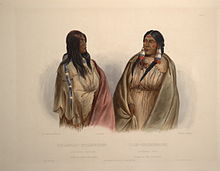CambridgeBayWeather (talk | contribs) Reverted to revision 303040029 by Justin Mahikan; Unsourced notability. (TW) |
|||
| Line 198: | Line 198: | ||
==Notable Cree== |
==Notable Cree== |
||
[[Image:Mähsette Kuiuab Chief of the Cree indians 0022v.jpg|thumb|Mähsette Kuiuab, chief of the Cree indians]] |
[[Image:Mähsette Kuiuab Chief of the Cree indians 0022v.jpg|thumb|Mähsette Kuiuab, chief of the Cree indians]] |
||
| ⚫ | |||
*[[Irene Bedard]], actress |
*[[Irene Bedard]], actress |
||
| ⚫ | |||
*[[Harold Cardinal]], writer, political leader, teacher, and lawyer |
*[[Harold Cardinal]], writer, political leader, teacher, and lawyer |
||
| ⚫ | |||
*[[Tantoo Cardinal]], actor |
|||
| ⚫ | |||
*[[Michael Greyeyes]], actor |
*[[Michael Greyeyes]], actor |
||
*[[Tomson Highway]], |
*[[Tomson Highway]], playwright, librettist of the first Cree language opera |
||
*[[Delia Opekokew]], lawyer and activist |
|||
*[[Bronson Pelletier]], actor |
|||
*[[Buffy Sainte-Marie]], singer |
*[[Buffy Sainte-Marie]], singer |
||
*[[Cree Summer]], singer/actress |
*[[Cree Summer]], singer/actress |
||
*[[Gordon Tootoosis]], actor |
*[[Gordon Tootoosis]], actor |
||
*[[Shania Twain]], singer/songwriter born to a father of Cree heritage, adopted by [[Ojibwa]] stepfather as a baby. |
*[[Shania Twain]], singer/songwriter born to a father of Cree heritage, adopted by [[Ojibwa]] stepfather as a baby. |
||
| ⚫ | |||
| ⚫ | |||
*[[Bronson Pelletier]], actor, will play Jared in the highly anticipated film ''[[New Moon (2009 film)|New Moon]]'' |
|||
See: [[:Category:Cree people|Cree people]] |
See: [[:Category:Cree people|Cree people]] |
||
Revision as of 15:22, 22 July 2009
 Nēhiyaw camp near Vermilion, Alberta | |
| Regions with significant populations | |
|---|---|
| Canada, United States | |
| Languages | |
| Cree, English, French | |
| Related ethnic groups | |
| Métis, Oji-Cree, Ojibwe |
Cree is one of the largest group of indigenous peoples in North America, located mainly across Canada and historically in the United States from Minnesota westward but are found today in Montana.
The Cree are generally divided into 8 major groups: Naskapi, Montagnais, Attikamekw, James Bay Cree, Moose Cree, Swampy Cree, Woods Cree and Plains Cree. However, among the Cree, they usually referred to themselves collectively as Nēhilawē[1] (those who speak our language); they called themselves "Cree" only when speaking English or French.[2]
Skilled buffalo hunters and horsemen, the Plains Cree were allied to the Assiniboine and the Saulteaux before encountering English, Scottish (especially Orcadian) and French settlers in the 16th century.
Name
The name "Cree" is an exonym derived from the French "Christenaux" (also as "Knistenaux", "Cristeneaux" and many other variations) that is commonly shortened to "Cri,"[3] after their village of Kenisteniwak.[4] However, among the Cree, depending on the community, they may call themselves as the Nehiyaw, Nehithaw, Nehilaw, Nehinaw, Ininiw, Ililiw, Iynu or Iyyu. These peoples can be divided into two major groups, those who identify themselves using a derivative of their historical appellation Nēhilawē (meaning "[those who] speak our Nation's language") and those identifying themselves using a derivative of their historical appellation Iliniw (meaning "person" or "man").[5] Both groups share a common ancestry but are now divided mainly along linguistic lines. Those residing west of the Ontario border (except for the Rocky Cree sub-group of the Swampy Cree, and one group residing in Quebec mistakenly called Attikamek but who self-identify as Nehiraw) all the way to the Rocky Mountains tend to refer to themselves using the first name, "Nehilaw". The second group includes the Rocky Cree and all the groups east of James Bay, who tend to use the term for man "Iliniw". [citation needed]
Language
The Cree language (also known as Cree-Montagnais, Cree-Montagnais-Naskapi) is the name for a group of closely related Algonquian languages spoken by approximately 117,000 people across Canada, from the Northwest Territories to Labrador, making it by far the most widely spoken aboriginal language in Canada.[6] Despite numerous speakers within this wide-ranging area, the only region where Cree has any official status is in the Northwest Territories alongside 8 other aboriginal languages.[7][8]
The aforementioned two major groups speak a mutually-intelligible Cree dialect continuum, which can be divided by many criteria. In a dialect continuum, "It is not so much a language, as a chain of dialects, where speakers from one community can very easily understand their neighbours, but a Plains Cree speaker from Alberta would find a Québec Cree speaker difficult to speak to without practice."[9]
One such major division between both groups, however, is that the Eastern group palatalizes the sound /k/ to either /ts/ (c) or to /tʃ/ (č) when it precedes front vowels. There is also a major difference in grammatical vocabulary (particles) between the groups. Within both groups there is another set of variation around the pronunciation of the Proto-Algonquian phoneme *l, which can be realized as /l/, /r/, /y/, /n/ or /ð/ (th) by different groups. Yet in other dialects, the distinction between /e:/ (ē) and /i:/ (ī) have been lost, merging to the latter. In more western dialects, the distinction between /s/ and /ʃ/ (š) have been lost, both merging to the former.
If you compare the consonants /p/ /t/ /c/ and /k/*[10] to their English counterparts, it is noticeable that there is little distinction of voicing. In English voicing marks the difference of meaning in words such as bin : pin. Since there is not distinction of voicing in Cree, it is common for variants of /t/ to sound more like /d/ without any difference in meaning. [11]
In Canada

The Cree are the largest group of First Nations in Canada, with over 200,000 members and 135 registered bands.[12] This large number may be due to the Cree's traditional openness to inter-tribal marriage. Together, their reserve lands are the largest of any First Nations group in the country.[12] The largest Cree band and the second largest First Nations Band in Canada after the Six Nations Iroquois is the Lac La Ronge Band in northern Saskatchewan.
The Métis (from French Métis - any person of mixed ancestry) are people of mixed ancestry such as Nehiyaw (or Anishinaabe) and French, English, or Scottish heritage. According to Indian and Northern Affairs Canada, the Metis were historically the children of French fur traders and Nehiyaw women or, from unions of English or Scottish traders and Northern Dene women (Anglo-Métis). It is now generally accepted though in academic circles that the term Métis can be used to refer to any combination of persons of mixed Native American and European heritage, although historical definitions for Metis remain. Canada's Indian and Northern Affairs specifically but broadly define Metis to be those persons of mixed First Nation and European ancestry.
In the United States
Though at one time located in northern Minnesota, North Dakota and Montana, today the Cree population in the United States can be found as part of the Chippewa Cree tribe, located on the Rocky Boy Indian Reservation in Montana. The reservation is shared with a Pembina band of Chippewa Indians who form the "Chippewa" half of the Chippewa Cree tribe. Traditionally, the southern limits of the Cree Territory in the United States were the Missouri River and the Milk River in Montana.
Cree First Nations

Notable Cree

- Janice Acoose, author, Sakimay (Saulteaux) and Ninankawe Marival Metis ancestry
- Irene Bedard, actress
- Harold Cardinal, writer, political leader, teacher, and lawyer
- Lorne Cardinal, actor
- Tantoo Cardinal, actor
- Jonathan Cheechoo, NHL hockey player
- Michael Greyeyes, actor
- Tomson Highway, playwright, librettist of the first Cree language opera
- Delia Opekokew, lawyer and activist
- Bronson Pelletier, actor
- Buffy Sainte-Marie, singer
- Cree Summer, singer/actress
- Gordon Tootoosis, actor
- Shania Twain, singer/songwriter born to a father of Cree heritage, adopted by Ojibwa stepfather as a baby.
See: Cree people
See also
- James Bay Cree hydroelectric conflict
- Métis
- Michif
- Cree language
- Cree syllabics
- Oji-Cree
- Politics of Saskatchewan
- Iynu
- Okichitaw
- Run to the Hills
References
- ^ "[T]heir native name", see David Thompson: Travels in Western North America 1784-1812.
- ^ David Pentland, "Synonymy" in Handbook of North American Indians, vol. 6, June Helm, ed., Smithsonian Institution, Washington (1981), 227.
- ^ David Thompson recorded "The French Canadians...call them 'Krees', a name which none of the Indians can pronounce...", "Life with the Nahathaways" in David Thompson: Travels in Western North America 1784-1812, Victor G. Hopwood, ed., Macmillan of Canada, Toronto (1971), p. 109.
- ^ Edward S. Curtis's The North American Indian - Uncorrected OCR Text for volume 18
- ^ David H. Pentland, "Synonymy" in "West Main Cree", in Handbook of North American Indians, June Helm, ed., Smithsonian Institution 1981, Washington, D.C., v. 6, p. 227.
- ^ Statistics Canada: 2006 Census
- ^ Northwest Territories Official Languages Act, 1988 (as amended 1988, 1991-1992, 2003)
- ^ The western group of languages includes Swampy Cree, Woods Cree and Plains Cree, and the eastern language is called Moose Cree; see "Languages of Canada", Ethnologue Languages of the World, http://www.ethnologue.com/show_country.asp?name=canada, accessed 21 September 2008.
- ^ "Cree", http://www.languagegeek.com/algon/cree/nehiyawewin.html, accessed 21 September 2008.
- ^ * Most dialects have these consonants.
- ^ Wolfart, H. C., and Janet F. Carroll. Meet Cree: A Guide to the Language : Second Edition. New York: University of Alberta P, 1981
- ^ a b Source: Canadian Geographic
- ^ Moose Cree First Nation community profile
Sacred Legends of the Sandy Lake Cree. James R. Stevens, McClelland and Stewart Ltd, 1971
External links
- Cree cultural site
- Grand Council of the Crees (GCC) website
- The Plains Cree - Ethnographic, Historical and Comparative Study by David Mandelbaum
- Lac La Ronge Band website
- Little Red River Cree Nation website
- Brief history of Cree from Canadian Geographic
- Grant, Bruce (2000). The Concise Encyclopedia of the American Indian. New York: Wings Books. ISBN 0-517-69310-0.
- CBC Digital Archives - James Bay Project and the Cree
- Pimooteewin, a first Cree language opera
- Fisher River Cree Nation Official Website
- The Gift of Language and Culture website
- Cree language Wikipedia
- CBC Digital Archives – Eeyou Istchee: Land of the Cree